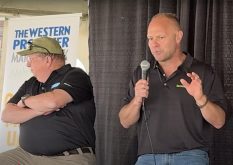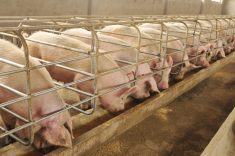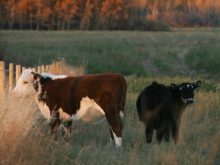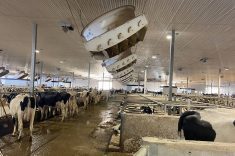OLIVER, B.C. – Robert Quaedvlieg is a professional fur trapper turned starling control specialist.
Approached by the British Columbia Fruit Growers Association in 2003, Quaedvlieg developed a bird control program where he and a small team of trappers captured 60,650 starlings in the Okanagan Valley in the first year. It is estimated the birds do $3 million worth of damage annually to fruit and berry crops.
The birds were introduced to North America from England and have been a problem in the area since the 1950s.
“They really seem to like to focus on the orchards and vineyards,” said Quaedvlieg.
Read Also

VIDEO: British company Antler Bio brings epigenetics to dairy farms
British company Antler Bio is bringing epigenetics to dairy farms using blood tests help tie how management is meeting the genetic potential of the animals.
Growers have tried scare tactics using noise cannons or falcons to chase the birds, but the starlings always returned.
The birds arrive in swarms like a giant cloud over an area. They can demolish grapes, cherries, apples and berry crops. The fruit is pecked full of holes and may carry bird droppings, making it an automatic cull with no salvage value.
The starlings also like sweet and forage corn. They peck partway down the cob, ruining it. Starlings have also moved into feedlots and dairies, lining up along the feed bunks to gobble up corn, barley and other feed.
The birds generally stay in the valley because of the mild winters so traps are monitored year round. Trapping during the late winter and early spring months may be the key to the major reductions in starlings.
“We trapped in Oliver last March and April and caught almost 7,000 birds,” Quaedvlieg said.
They use 22 conventional traps and five drop trap systems in the Oliver, Kelowna and Vernon areas. Both traps have caught as many as 700 birds in two hours time.
The conventional trap is an upright hutch covered with hardware wire where the birds slip in through a slot at the top to feast on fruit left as bait inside.
They cannot escape and are removed in a special wood and wire cage.
Quaedvlieg also developed a drop trap that is propped up with posts and can be dropped down by a car remote control while the birds are eating bait fruit on the ground.
The traps can hold as many as 200 birds at a time.
Non-target birds are released.
When the trap is full, the birds are lured into a flat wooden box with a wire cover where they are then covered with plastic. Carbon dioxide is pumped in and they are dead within 15 seconds. They are then quickly frozen and sold for 10 cents each to a falconer who uses them to feed his birds.
Some trapping has started in Washington state where there is a 40 cent bounty on the birds to encourage people to remove them.
Part of the problem with this invasive, territorial bird is its prolificacy. A pair of starlings produces two litters per year averaging five young per nesting. They nest in abandoned woodpecker holes or any other cavity they find.
Quaedvlieg recommends growers plug woodpecker holes and other openings where the birds may crawl in and nest. In some cases the birds move into ceramic roofing tiles, eaves or pipes around houses.
“When I started trapping I was up at the crack of daylight and I watched where the birds went to roost and where they fed, so I could learn as much as I could about them and their behaviour.”
He has learned trap placement is important. If they are placed in the middle of a cherry orchard the birds are not likely to be lured in because they can eat fresh fruit off the trees.
“There are other fruit eaters that do some damage but nothing like the starlings,” said Quaedvlieg.
The trappers try to catch the birds during the morning feeding time to be most effective. They may also leave a few live birds in the trap where there is always food and water.
“The way I look at it is we are helping the farmers out. This is what this whole valley is,” said Harry Bray of Oliver, who works with Quaedvlieg.
“You try to leave at least a half dozen starlings in it as a attractor. When a flock of 20 comes along and see their buddies in there eating, then they’ll land all over.”
The year Bray started trapping in the Oliver area, he caught 6,000 birds. Last year he caught 1,500 so the numbers are falling and new birds do not seem to take over the territory right away.
“We did definitely put a dent in them,” he said.

















